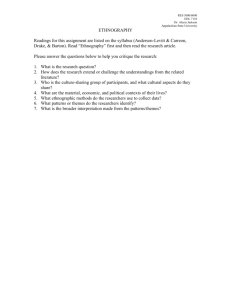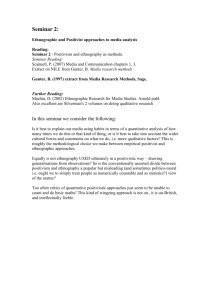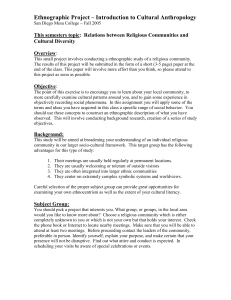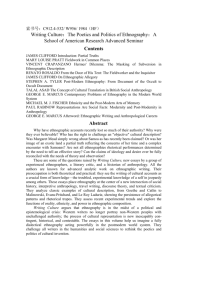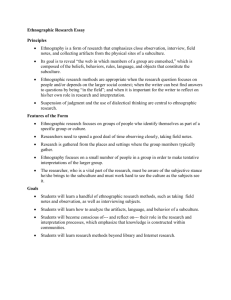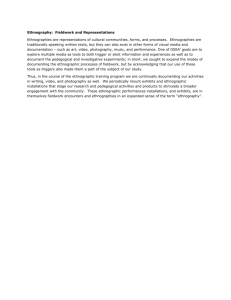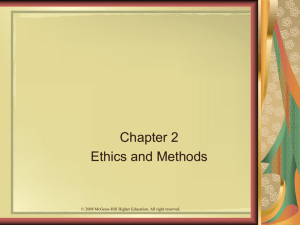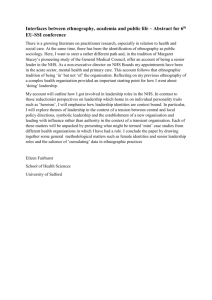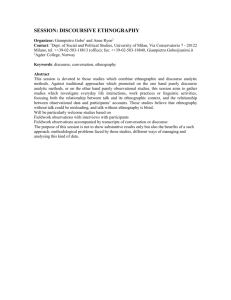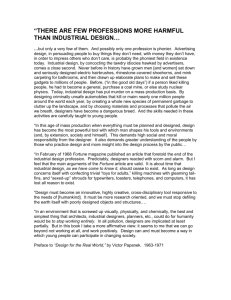Group2EthnoFieldMethods
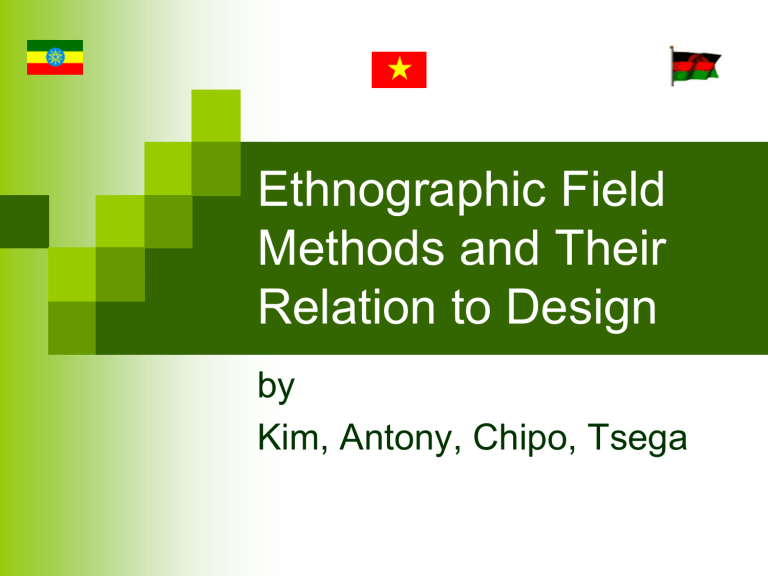
Ethnographic Field
Methods and Their
Relation to Design
by
Kim, Antony, Chipo, Tsega
Goal of the Paper
Exploring relationship between:
developing a descriptive understanding of human behaviour and
designing artifacts which support them
Overview
Introduction
Ethnographic Approach
Ethnographic Field Methods
Ethnography and Design
The Participatory Design Project
Conclusion
Introduction
Challenge of linking ethnographic field methods and design
Ethnographer’s interest is understanding human behaviour
Designer’s interest is designing artifacts
1980s designers refocused interest & realization of inappropriateness of methods used
Ethnographic Approach
Requires and includes:
involved field work
description of activities and practices
Interpretation of activities studied
Has Four main Guiding Principles:
Natural settings
Holism
Descriptive
Members’ point of view
HOLISTIC
DESCRIPTIVE
Blomberg et al. , 1993 s. 128-
129
Blomberg et al. , 1993 s. 128-
129
Ethnographic Field Methods
Requirements when doing field work:
Personal involvement of investigator
Willingness to be in situations out of control
An abandonment of strict “ scientific control”
Ethnographic Field Methods…
The Methods include:
Observation
Note taking
Interviewing
Video Analysis
Observation
Why observe?
How should observation be done?
What should the focus of the observation be?
Note taking
Very individual activity
Useful to evoke memories of experienced events
Videotaped records as notes
Interviewing
Observations coupled with interviews
Start with unstructured & open-ended questions
Then conduct more structured & systematic interviews
Should be done in local setting
Can be combined with observation
Carefully plan who to interview
Rules of thumb in interviewing
Video Analysis
Used as supplements of substitutes to field notes
Can be viewed and analyzed by a wide range of people (researchers, designers…)
Caution needs to be taken as:
video taping generate large quantity of tape
time consuming to analyze
some human activities are difficult to record
Traditional Approaches
Customer Surveys
Operability Assessments
Focus Groups
Field Trips which could either be:
Field visits or
Field tests
Ethnographic vs. Traditional
Approach
Ethnographic
On-going relation with users
Incorporates users perspectives
Relation between tech & work understood
Provides a context to evolve mutual understanding
Traditional
Limited to provision of functionality to end-users
Evaluation in imaginary setting
Technology driven
Little room for collaboration
Ethnography and Design
When using ethno in design, the human behaviour needs to be understood as a mechanism for change
Individuals for whom a system is being designed must come first
Ethnography and Design
There are Participations and Expectations
Involving those studied, one gains new understandings
Interests of those studied should be respected
Early involvement of users crucial
Issues of access & reciprocity must be confronted
Access the settings without promises
Ethnography and Design
Why ethnography is relevant to design?
designers to understand the settings
not to impose designers’ view on users
helps explain uses of the tech designed
users gain broader perspective on tech
gives good understanding of users work
reduces focusing on single task
Ethnography and Design
How can ethnography and design be linked?
ethno study work practices & transfer insights to designers
team of ethno & designers undertake the study together
team of ethno, designers & users
Success depends on how well tech supported the work activities
The Participatory Design Project
conducted by researchers at PARC & designers in the ID/HI at Xerox
to explore ways of linking ethno & design
team comprise anthropologists, graphic & industrial designer, human factors & users
Goals of the Project
understand user work practices
develop new ways of incorporating the understanding into design
integrate lessons learned into Xerox product dev.
focus is on relation btwn tech & human activity
Project Methodology
first designers needed grounding in ethno
& two workshops held
wkshp1- perspective on ethno, observation, open-ended interviews & audio & video rec.
wkshp2- analysing & interpreting info. rec
then team interviewed users
analysis of results
construction of collage of ideas, issues..
translation into possible design concepts
Project Scope
worked with one user community
choice of comm. based on:
comm. had broad range of technologies
rich array of documents
variety of media
Eagerness by the community
Conclusion
designers gain a new way of thinking & understanding when ethnographic field methods are used
it is important that the designers first understand how to translate the insights
